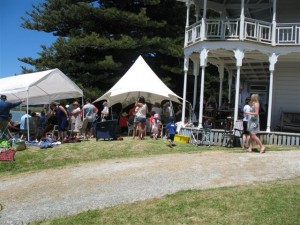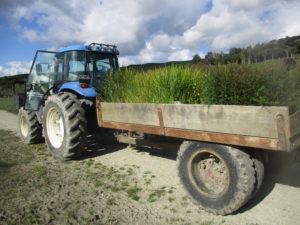
Coolest trailer carrying seedlings poised for planting.
As the farmer set off to work with four professional tree planters, I thought about the behind-the-scenes effort that’s often required to produce results.
Years of grit, guts, luck, courage, team work and a heap of money was behind our thrilling America’s Cup win. On average, each race took a few minutes short of 25. I’ll set the average at 20 which is perhaps a tad low, but remember nose-dive day? It counted but we didn’t cross the start line.
Our fast and, as it turns out, frail Aotearoa set sail 33 times – 10 in the Louis Vuitton Round Robins, seven a piece in the semis and finals and nine nail-biters against Oracle. This multiplies tidily to 660 minutes or just 11 hours of racing after an investment of gazillions of dollars and labour hours.
Now let’s look at the Melbourne Cup. In 1990, Kingston Rule finished in a record three minutes, 16 and a half seconds. Even the slowest time is less than four minutes. Vast amounts of skill, work, luck and money got those horses to the starting line – then finish line first.
Now to tree planting, less sexy but ain’t that life. No shiny silver cups, no roaring crowds or pots of prize money.
To have professional tree planters rock up, as if by magic, and plant 1000 baby native trees in two hours on the shore of the Kaipara Harbour has taken years of work by man with a mission Mark Vincent, countless volunteers and the farmer who’s fenced the shoreline, bought trees, divided flaxes, planted, planted and planted – and got involved with Otamatea HarbourCare.
It’s the brain child of Mark Vincent who’s created a native plant nursery, acquired seeds and seedlings and all they require to grow, nurtured them, got sponsorship, organised working bees and planting days, inspired celebrities to get on the end of spades (Te Radar, Paul Henry and our Kaipara mayor), delivered trees to planting sites, dug too many holes and done too much more to list here.
All this earned Otamatea HarbourCare the credibility to get funding for professional tree planters. They came courtesy of Reconnecting Northland and its Go with the Flow: Northern Kaipara Harbour Project.
Reconnecting Northland is the first WWF-NZ and NZ Landcare Trust project of its type and is designed to restore “natural processes and ecosystems”, while Go with the Flow is about restoration and working with landowners.
And there we were last Thursday with potted plants jam-packed on the oldest and coolest trailer I’ve ever met. Odd fact that relates to this yarn – the farmer bought it from the second female to ride in the Melbourne Cup, Linda Ballantyne, who used to live nearby.
In just two hours the four guys planted 1000 plants. Snap! Job done! But mostly tree planting is DIY and not quite so speedy. On Wednesday 16 August we’re having a planting day here at Batley and need new blood in our team, even if just for this project. You needn’t dig holes. That’s the domain of strong blokes. I generally follow along and pop in trees. Easy.
Beforehand you’ll have morning tea and learn about our 150-year-old house at Batley on the Kaipara Harbour near Maungaturoto and afterwards we’ll gather for lunch. Please say yes.
The harbour needs you, you’ll help our beleaguered planet and make a positive difference. Questions are welcome and RSVP is essential. Please message the Otamatea HarbourCare Society’s Facebook page.
]]>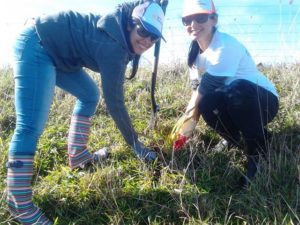
Spark staff, from left, Rachita Dahama and Gurpreet Jaura planting the coastline at Batley on the Kaipara Harbour.
People power to plant the edge of the largest harbour in the southern hemisphere is being provided gratis by one of our country’s largest companies.
Spark NZ, through its charitable arm the Spark Foundation, enables its staff to spend a day a year contributing to a worthy cause. Last week, 11 Spark people turned their attention to waterfront land at our place where hundreds of native saplings sat ready to be planted.
Mark Vincent, the initiator of Otamatea HarbourCare, which has a goal of planting many kilometres of harbour waterways, had grown them in his nursery with the help of volunteers. The week before Mark had attended another planting day, this one with children from diverse backgrounds. Although they were horticulture students, they turned up in school uniforms. No gumboots in sight.
We were luckier, despite many of our guests having begun life in other countries – or their parents had. Most were quietly spoken, making communication a test; when a young man waved a paper cup and said ‘Rubbish bin’, I thought he said ‘Aspirin’ and offered him a Panadol. We worked it out.
We also struck luck with the weather. Friday dawned still, clear and beautiful. Our guests arrived when the tide was in and began taking photos of our calm and glittering Kaipara Harbour.
While eating pikelets and muffins (cooked by the farmer’s mother), we introduced them to the place – they were beside the Otamatea River, the central arm of the harbour and in a house that began life in 1866. And that’s one reason Mark chose Batley for the first Spark Foundation day – we’re on the waterfront and the house and area abound with wondrous stories. The first settlers, for example, had seven daughters but only one reached adulthood. Twins were still born, three girls drowned and another died of pneumonia and is buried on the hill behind our house.
After planting, we served lunch to our rather exhausted guests. Practice has taught us that soup is the answer when feeding a large or unknown number of people. It can be eaten standing up if necessary and can cater for all diets. We served pea and ham, seafood chowder and Thai pumpkin.
While we were from different worlds, we women bonded over the pumpkin soup. It’s simple and delicious. First, split your pumpkin. This doesn’t need a knife or the slightest effort. Drop your pumpkin, with force, on a hard surface like your concrete drive or path. It will break in two, easing the business of cutting it into pieces.
Already another batch of pea and ham soup is in the freezer and I’m primed to crack another pumpkin on our concrete courtyard. Our second group of Spark volunteers is due soon.
Margaret’s Thai Pumpkin Soup
(I name recipes after those who give them to me – our visitors took away a recipe for Rae’s Thai Pumpkin Soup.)
1.5 kg pumpkin (I bake the pieces, cool then peel them).
2 onions, chopped
3 stalks celery, chopped
4 cups chicken stock (use vegetable stock to cater for vegetarians)
1 Tb red curry paste (Gregg’s is good and the only one I use)
Simmer the lot, whizz till creamy then add a can of coconut cream. It is especially lovely with coriander sprinkled atop its surface.
]]>
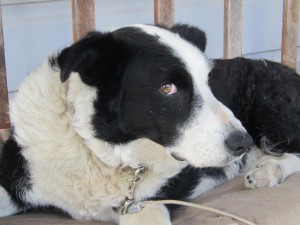
Photo by Geoff Walker
Dear Readers,
I can hardly believe it, but I’m having to backtrack on a bold declaration made in a previous column. Early this year I declared full of certainty that while Jas the puppy could bark and jump and beg, she would never, ever make me play. I backed up this emphatic statement by saying that I’m 13 years old, which puts me in my 70s in dog years, well past the time of playing just for fun.
Obviously I jump up and down with excitement when it’s food time, when my boss gets home, when my boss takes me for a walk or when I find her in the garden. But these situations don’t qualify as playing.
Playing is what Jas the puppy does. It involves jumping, spinning and dancing for no reason whatsoever. Why, I used to wonder, does Jas think dropping into what you humans call the ‘soliciting play’ position will make me play? Just in case you’re not clear, soliciting play when done by dogs involves poking the front legs forward, dropping the chest on the ground (which happens when the front legs are thrust forward) and poking one’s backside in the air
This ingratiating position also involves vigorous tail wagging, although this barely rates a mention as vigorous tail wagging is automatic for dogs when we’re pleased. On the odd occasion I’ve felt pleased and have tried not to wag my tail, it’s been an epic fail. That tail of mine has a mind of its own.
Anyway, on the fated day when I played for no reason whatsoever, I’d followed my boss Rae into the paddock when she went to give the horse a snack. Already, I was acting strangely because I often only follow her part way to the horse.
You can’t kid me that this counts as a walk. A walk is when she devotes her attention to me and I follow her. Walks are mostly along the beach and moving bulls. They used to include paddocks, but I’m now suspicious when she goes into the big paddock by the house because she might just be going to visit or catch the horse. Last week, I was suspicious as usual, then I realised my boss was off to gather mushrooms. I had to run to catch up.
Anyway, on this day she’d fed the horse and was walking home when this unearthly desire to play overcame me. It was as if I’d been taken over by the character of Jas the puppy who was standing nearby. I jumped, I lunged, I spun around and I dropped into that ingratiating solicit play position and begged my boss to play. She grinned and I thought she was going to laugh at me but she jumped and frisked and lunged and ruffled by furry neck and together we played in the paddock. Golly, it was fun.
For once Jas didn’t play at all. This silly and thrilling moment was just for me and my boss. Then the feeling passed and even though my boss patted me on the head and told me she loved me, it hasn’t happened since.
It was, I’ve decided, a moment that may never be repeated. Note my use of the word ‘may’. Once I’d have said never but now I’ve learned never to say never. Oh, perhaps I’ll amend that because I know myself too well – I’ve learned almost never to say never.
Your friend, Floss.
]]>
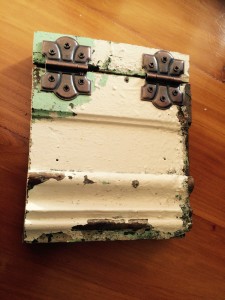
Special notebook – made with love and Batley House skirting board
It was surely a world first. A bloke who contacted me to buy a copy of my book asked for a hunk of the house as well.
“Sure,” I replied. “I’ll see what I can find.” Dave suggested weather board, but a scavenge in the wood heap in the back paddock turned up something I thought would be even better. As I inspected the piece of skirting from the bathroom, back when it was white and that old-fashioned pale green, I wished for the creativity to do something clever with it. A small hole added to its rustic charm. The farmer says it accommodated a water pipe.
I posted it with a copy of ‘Love at the End of the Road’ and, soon afterwards, Dave reported that the gift had been a success. He knew this because when Vicky received my book and the notebook he’d made using the wood as a cover, she was overcome with emotion. The reason for her tears – Vicky lived here in the 1960s and 70s when children from families in strife stayed at Batley House which had started its life a century earlier as a home, boarding house and store.
A few weeks later, Dave, Vicky and her sister Michele visited. Twice they’d been to Batley, but had been hesitant about returning to their former home. This time, here they were in our living room remembering not just what the house had been like back then, but what their lives had been like.
When they arrived in 1967, Vicky had a special honour. Lance and Olive Field, who had foster children and cared for children from troubled homes during school holidays, drew the line at babies – except for Vicky. She and her four siblings were wards of the state. Their father was in prison and their mother wasn’t coping. Of course, they had to be together.
“We loved it here,” said Michele as they remembered being called to meals by a bell and siren, the massive vegetable garden and the loving care and guidance provided by Lance and Olive. There had been excitement chasing possums in the night, and thrills sliding down the bank in front of the house on a wet plastic sheet. One boy, going rather too fast, flew high and landed on the road. The children loved to swim. One day Lance had screamed, “Get out of the water.” The kids, not used to hearing his voice raised, obeyed – and just as well. A five-metre shark cruised along nearby.
Lance and Olive showed the children nothing but kindness. The only time he got angry was when he put a stop to the mischievous kids’ attempt to dig up the grave on the hill behind the house.
“We thought it was a Maori princess,” recalls Michele. It’s the grave of Grace Masefield, a daughter of the first settlers who died in 1874.
Batley House was the only place the five children stayed together. In other homes, Vicky, Michele, their two sisters and brother were separated and sometimes endured harsh conditions.
“We felt privileged to come here,” they said. “We didn’t have a home. When we thought of a home, this is where we’d think of.”
And now, almost half a century later, Vicky’s notebook is a permanent reminder of the place she and her siblings call home, the place where they were cared for and loved.
Love at the End of the Road is now an ebook: /Rae-Roadley/e/B013Q6NKWY
]]>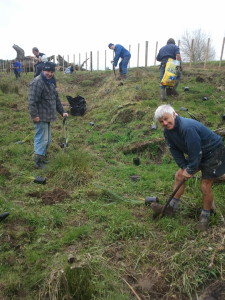
Otamatea HarbourCare members – the farmer front left – getting stuck in planting natives to improve water quality in the Kaipara Harbour.
Each morning I’m a picture of sartorial style in muddy overalls, beanie and gumboots as the farmer and I move cattle. Up until the big wet we moved young bulls in the intensive grazing system every two days, but now they’re in smaller paddocks. In larger areas they stomp the lot to muck by the end of day one and stage a mutinous break-out in day two.
As it was, there were break outs because the electric fence system took a hammering in the storm. But that’s a tiny glitch compared to what many farmers are facing, plus I’ve found returning Houdini cattle to their paddocks to be surprisingly satisfying.
My dog Floss and I sometimes walk several hundred metres to bring back escapees. One lot spotted me as I approached and came running at a gallop, like naughty schoolboys who’d been caught out. There’s always one laggard and as we plodded to get him, I expressed this to Floss in strong farmer language. The big wet does tend to inspire a colourful vocabulary, even among lucky ones like us.
The farmer calculated that at flood’s peak, only about one percent of the farm was under water. Some farmers have 90 percent of their land swamped. That morning Floss and I did face a sludgy battle of wills, but the bulls eventually galloped into a valley and up the other side and were soon with their mates. I was thrilled.
Then, last Saturday, cattle moving done, the farmer and I picked up spades and headed off to plant native trees. I also find it surprising satisfying to head off the farm clad in muddy overalls and gumboots and not give, as my dog Floss would say, a dog’s biscuit what I look like.
It was my second planting of the week and the farmer’s third. With the manager and helpers, he’d planted about 1200 natives on the edge of the farm, then he and I dug up flaxes that had taken root in his mother’s garden. After separating the big ones, we planted about 70 between the coastal fence and harbour.
“They don’t go far,” observed the farmer after we were done.
On Saturday we attended the inaugural planting day of the fledgling Otamatea HarbourCare group which has the slogan, ‘Productive land with a healthy harbour’.The team put in about 750 flaxes, cabbage trees and manuka by a waterway on a farm that borders State Highway 12. It will be a living advertisement for the group and the massive and long-term effort required to plant the edge of the Kaipara Harbour to reduce run-off and increase water quality.
Afterwards we gathered in a farm shed. As lunch came to an end, it was time for a speech acknowledging the momentous occasion. Mark Vincent, who’s taken on the task of getting the group going, drew inspiration from Winston Churchill: “Now this is not the end. It is not even the beginning of the end. But it is, perhaps, the end of the beginning.”
If spending a weekend morning in mud and gumboots (overalls optional) and leaving a legacy of coastal plants appeals, you can find out about future planting days by emailing mark.cindy.vincent @ gmail.com (remove the spaces which are there to prevent spam).
]]>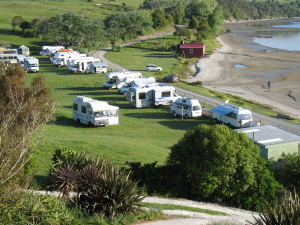
Campervans in a paddock where it’s legal to park because thei owners have kindly asked.
I hadn’t thought ‘lightly’ and ‘politely’ could be interchangeable until a letter from a rental vehicle company proved that, indeed, this is so.
We share a Kaipara beach with ‘no camping’ signs which were ignored by some freedom campers I met during a preprandial wander. The couple, whose van had been parked all day, were relaxing on deck chairs on the beach. The man acknowledged me, but the stiff set of the couple’s backs indicated they had no wish to chat.
I walked past their van, past a fire on the beach and . . . .urghhh!!! . . . past dirty pieces of tissue paper near the boat ramp. Yick!!!
As if by karma, a clean plastic bag lay at my feet. I used it to gather the toilet paper then approached the stiff-backed couple who told me they were from Europe and that this was their third New Zealand holiday.
I politely mentioned the no camping rule and offered a camping spot in a nearby paddock. The declined and looked surprised when I said the beach was popular with boaties and families and that there was a nearby toilet.
“Some naughty people used the grass as a toilet,” I said, indicating the ‘treasures’ in the plastic bag.
They left the next day leaving wood on a fire that smouldered near dry kikuyu.
What would you do? I wrote to the vehicle hire company and days later received a prickly reply informing me I’d made incorrect assumptions. The writer also asked why I hadn’t lightly pointed out that camping wasn’t permitted.
Confused, I checked my letter and found I’d made no assumptions, incorrect or otherwise – I hadn’t accused the company of not educating campers, but said I’d been unable to find this info on their website. And in the circumstances, was the tone of our interaction relevant? Now I felt prickly.
I replied saying that, in fact, they had made an incorrect assumption as I had spoken “lightly” to the campers when I offered them a legal camp site.
A few days later, glancing at the grouchy letter, I realised I’d misread it. I don’t mean to make fun of the writer’s spelling ability – we all have different strengths and weaknesses – but I’d been asked to speak “per lightly” to the campers, i.e. “politely”.
In my chummy reply, I’d agreed with the writer’s idea that, if a similar thing happened again, I should contact the relevant car hire company. I didn’t mention that he’d incorrectly assumed I was a bloke.
]]>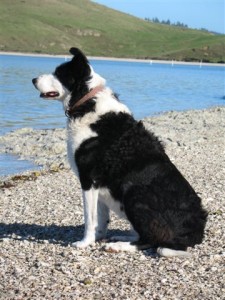
I tried to ignore my boss’s skirt.
A Blog by my Dog.
Dear Readers,
My boss recently went on a cattle moving mission dressed like a real girlie girl – and being a female, I’m qualified to comment. Oh, the shame!
I was, of course, wildly excited when cattle broke through a fence and got onto the beach. Not only is this illegal, but they hardly ever get onto the beach these days because the farmer’s done miles of coastal fencing. Pity, because dealing with cattle kicking up sand is fantastic fun. They’re excited and a good stiff ocean breeze gets them even more worked up.
We were in the ute on the way to sorting out the bulls when my boss spotted the place where they’d broken out – although there was a clue: one bull with its foot caught in the wire was bucking and jumping.
The farmer dropped my boss Rae and me then drove on down the beach to get the rest of the cattle – and that’s when I noticed the boss’s skirt. I kid you not, she wore a flimsy, pretty wrap-around skirt. Full length. It was flapping all over the place. Cattle, as you know, only like people in jeans. I took off after the ute, figuring if I ran really fast I’d catch up and . . .
“Floss, come back here,” called the boss in the voice she uses when she knows I’m not inclined to listen. Damnation!
Turns out it’s also the voice I can’t help obeying. Why is that? If there’s a question in the universe I’d like answered, it’s that one. I slunk back, sat beside her and thought, ‘Why did you have to wear that dumb skirt?’
Pretty soon, the farmer was herding the cattle towards the boss who was holding a stick with one hand and the flapping skirt with the other. This wasn’t going to go well.
But the clever farmer urged the bulls off the beach and up the bank to the break-out spot – where they gathered in a muddled huddle. No way would they jump the single low wire into the paddock. Bulls are odd like that – happy to jump over a wire to get out, won’t do the reverse.
Meanwhile, the farmer moved quietly around the bulls which were all gaping at my boss and her skirt. I knew their attention was making her nervous.
“Stay there, bullies,” she called before yelling at the farmer, “I’m going to get the ute,” and took off at a gallop – or as much as a gallop as she could manage, what with the flying skirt and wearing gumboots. I followed. Couldn’t help myself.
After she got back and delivered a hammer and nails to the farmer, he lowered the troublesome wire and the bulls ambled into their paddock.
On the way home my boss’s words whistled past my super-sensitive ears: “Did the tangled bull free himself or did you do it?”
“I did,” said the farmer whose face had been twitching with amusement for some time (there was a lot to laugh at – my boss, her skirt, her nervy attitude, her ungainly gumbooted canter). “I wrestled it to the ground and unwrapped the wire. The judges gave me 9.5.”
I knew this was nonsense, but I don’t think my boss did because she just grinned and said nothing.
Yours truly, Floss
(Hope you enjoyed this – I do enjoy Floss’s point of view. I’d love it if you’d share this or comment here or on my Facebook page. Thanks.)
]]>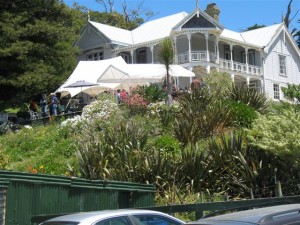
100th Birthday Bash at Batley was a blast – 130 or so, finger-food picnic, treats for the kids, glorious sunshine.
The Roadley family – about 130 of us – recently celebrated a century on a block of land whose first owner holds a dubious honour in New Zealand’s short history.
Thomas Spencer Forsaith, who in 1839 signed on to buy 2000 acres on the shores of the Kaipara Harbour, will hopefully always retain his record of leading the country for the shortest time ever. If not, presumably politics will be in the same upheaval as in 1854 when Forsaith led a group of politicians who held control for a mere three days.
The following year, the Government concluded that while Forsaith’s land purchase was legal, he was entitled to only 823 acres rather than the 2000 he’d attempted to snap up 16 years earlier for waistcoats, trousers, fowling pieces, sugar, flour, tobacco, iron pots and other essentials of the era.
On 11 November 1912, Albert Roadley (the grandfather of Rex my husband, better known on this blog as ‘the farmer’) and his brother Jack bought the land, known as Forsaith’s Grant.
By then it belonged to Joseph Masefield whose life hit a milestone 150 years ago on 12 November. In 1862, Joseph and his wife May, arrived on the William Miles, one of the ships carrying settlers who’d signed on for land under the Albertland Settlement Scheme. Within a month or so, Masefield had a supply store at Batley, then named Oahau.
Both Masefield and Albert Roadley travelled to the Otamatea River – one of the arms of the Kaipara Harbour – to check out land. Neither liked the property they’d set out to buy, however they both spotted land at Batley while on board a steamer and decided they liked it.
The run of significant November dates continues: 10th – Celebrate a Century party; 11th – Roadleys buy land at Batley; 12th – Masefields arrive in NZ; and 13th – 1820, Ngapuhi rangitira Hongi Hika is introduced to King George IV in London.
Hongi deserves a mention because he and his warriors killed the father of first person to get legal title to the two blocks of land which, along with Forsaith’s Grant, comprise today’s 1000-acre farm.
By 1820, Ngapuhi and Ngati Whatua had ceased their battles, but Hongi was plotting revenge. As he returned from England, he traded gifts from the King for muskets, then in 1825 he and his army headed south on a mission. When the fighting was over, Haututu was among the dead and, in an ultimate insult, his body was consumed at his kainga, just up the river from the farm, by victorious Ngapuhi.
It’s easy to look back and give the facts of history nothing but a passing thought, but in this context they have much more meaning.
At our celebrations, many members of the extended family met for the first time because we figured that when you’re celebrating a century you can spread the net wide. And we feasted both in 2012 style, with guests bringing a fingerfood picnic to share, and like the very first settlers, the Maori, we enjoyed the bounty of seafood-gathering missions.
]]>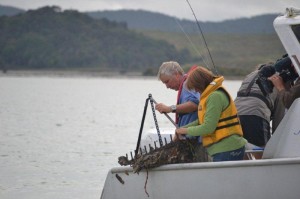
Scalloping on the Kaipara Harbour – taking scallops from the dredge while Richard Williams films us for Country Calendar.
The Country Calendar camera was rolling when the farmer flung himself off the couch and started crawling towards the kitchen. He’d been quietly reading the newspaper while producer/director Kerryanne Evans interviewed me.
Before filming started, we’d gone all out to ensure silence because the smallest sound gets picked up by the high-tech equipment. The fridge and water pump were off, an errant fly had been swatted and I’d glanced at the dishwasher and decided it had finished its cycle.
Being a professional, Kerryanne merely blinked and continued our interview while the farmer continued his stealthy, silent and sneaky crawl. Not being a professional, I lost my focus. Rex’s distracting journey finished at the dishwasher when he snaked out his arm and made a wild stab at a button.
All of us, Kerryanne, soundman, cameraman, Rex and me, dissolved into helpless giggles. Turns out, Rex could hear the dishwasher humming on its drying cycle and had turned it off.
Actually it was a change to have him trying to play by the rules as his tendency during interviews to slip in what he calls his ‘one liners’ must have landed the end of a few sequences on the virtual cutting room floor. Unfortunately, we were not like the Queen whose performance with James Bond for the Olympic Games opening ceremony was filmed in one take.
On one occasion we were being filmed walking on the beach and talking about fencing and planting the land on the edge the Kaipara Harbour. We’d nattered on about how we’d dug up and split massive flaxes and had planted the cuttings, then I started on about how I’d dealt with flax seeds.
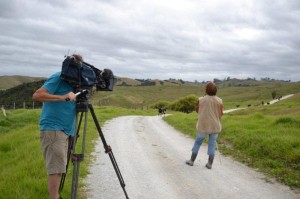
Preparing to act as a ‘gate’ while Rex drive bulls along the farm road. A few seconds later Richard filmed me waving a cattle stick like a demented windmill as I directed the bulls into the paddock at the left of the shot.
After making a concoction of compost and, um, cattle doings, I’d added flax seeds and enough water to make soggy yet solid balls. Having carried buckets of the cocktail to the beach by quad, I’d wandered along the waterfront, throwing the balls up banks in the hope the seeds would take and flax would grow.
“So you walked around throwing s**t everywhere,” said the farmer.
At which point the soundman, who is trained to be silent, burst out laughing.
The farmer delivered another one liner at the tail end of an interview about his new sheep handling device.
For years he’s farmed bulls, which can be contained by two-wire electric fences, while the few hundred sheep he keeps to remind himself not to farm sheep, have the run of the place. Insulated by their wool, they merrily slip through these fences.
These days, however, prices are good (or were), he’s got a sheep-friendly manager and so many sheep he needs to keep them organised.
“As you’re increasing your flock,” said Kerryanne, “you’ve got a lot of fencing to do, haven’t you?”
“I do,” replied the farmer. “Perhaps I’ll have to teach my wife to fence.”
This was a cue for more laughter – and a fencing lesson for me the next day atop a blustery hill. As I was a contrary student, that footage did make the show.
If you didn’t catch our episode of Country Calendar on TV1, you can watch it by clicking here.
]]>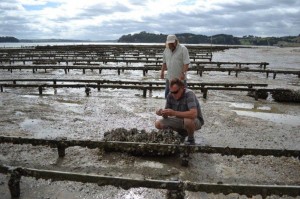
Country Calendar sound recordist Don Anderson (standing) and cameraman Richard Williams wasted no time feasting on the oyster farm.
“I’ve got eagle eyes,” trilled the farmer in a most unfarmerly fashion while strolling down the hall and waving something small and shiny.
“My watch!” I’d spent ages scouring the gravel road several kilometres from home where I was sure I’d lost it months earlier while moving bulls.
Remarkably, it was in perfect condition which was odd after weeks of weathering rain and vehicles.
I was having this thought when I noticed the farmer’s sheepish smile. Turns out he’d found it in his ute which he was cleaning, an event as rare as the times he arrives home after a hard day on the farm and says, “Don’t move a muscle. I’ll cook dinner. White wine or red?”
His domesticity was inspired by the impending arrival of a crew from Country Calendar, the television show that’s central to our Kiwi culture. It’s the country’s longest-running TV series, and is probably only pipped as the world’s longest-running show by Coronation Street which started in 1960, six years before Country Calendar.
Anyway, we were all of a dither, mowing, weeding, dusting and cleaning. And when you’re going to be on television and you’re female, you realise you own no suitable clothing and, in my case, hats.
After rushing out and buying a merino top, two friends immediately said it didn’t suit me and I returned it. I know my hats didn’t pass muster because I was wearing my favourite when the farmer said, “You look dorky in that hat.”
Fair enough. I’d told him he looked dorky in a particular pair of shorts the day before. These frank exchanges surely stemmed from pre-Country Calendar angst.
Some months earlier Kerryanne Evans, a director and reporter for the show, visited and we’d had another frank exchange while enjoying the farmer’s oyster fritters, answering more curly and personal, but gently put, questions than anyone else had ever asked.
She’d become interested in life at Batley after reading Love at the End of the Road about life on the shores of the Kaipara Harbour with the aforementioned not-so-eagle-eyed farmer.
Kerryanne visited when the harbour was bleak and wind ruffled. The next day was so glorious I took photographs of the bright blue harbour reflecting puffy cottonwool clouds and surrounded by electric green hills.
Soon after the filming dates were confirmed, things fell magically into line. The Mangawhai Garden Club planned to visit and agreed to do so while the crew was here, an Ohope Beach oyster farmer serendipitously timed his arrival to coincide, and some Otamatea High School students were to have a shearing lesson at the Country Club where Rex often helps at shearing time.
We located accommodation for Kerryanne, a cameraman and a soundman who’d spend five days here, then got busy tidying and straightening the house, farm and ourselves as much as we could, which in some respects, wasn’t much at all.
When Kerryanne asked if the Kaipara Harbour was always so grey and windswept, I emailed my blue-sky photos and she was most heartened. Then the week of filming turned out to be grey and windswept, perfect moody Kaipara Harbour weather.
Country Calendar, Saturday 11 August, 7.00pm, TV1.
]]>
